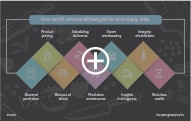IoT
Revolutionizing the Food Supply Chain with IoT
Food for thought: food services enterprises should have elasticity in inventory of produce while minimizing food waste. The business imperative: cater to the demand for processed food while ensuring food safety. The operations dynamic: maintain food quality while rationalizing costs.
On-demand distribution of huge volumes of products across diverse categories requires food services enterprises to capitalize on advanced technologies such as the Internet of Things (IoT) and big data analytics to integrate the supply chain and improve efficiency in packaging, warehousing and logistics. Solutions for real-time asset tracking and mobile workforce management boost productivity and streamline operations; however, they do not adequately raise service levels or minimize order lead times in complex shipping flows.
IoT supply chain management tools mine useful data within and beyond the enterprise to maximize asset utilization as well as customer value. Moreover, an IoT-enabled supply chain offers contextual intelligence. Analytical models use big data to predict demand for a certain time of day, recommend product pairing to avoid multiple orders, determine how many drivers are required in a shift, and schedule inbound as well as outbound vehicles to minimize truck rolls. Trimming even a few minutes from the dwell times of a delivery truck leads to substantial savings for the entire fleet.
An IoT ecosystem simplifies the business across several dimensions. It automates asset control, statutory compliance, and reconciliation of products and assets. In addition, it addresses the issue of hidden costs associated with loading equipment and returnable packaging. Predictive maintenance of trucks, forklifts and conveyors, and timely repair and maintenance of returnable containers, racks and pallets rationalize warehouse inventory and material handling costs.
IoT-driven logistics systems ensure the integrity of the cold chain. It adjusts discrete systems in the network automatically to avoid breach in threshold levels of humidity and temperature in warehouses and trailers. Device-generated data provides real-time audit trails for food safety professionals, and helps supply chain planners identify and analyze the root cause of issues in the cold chain.
IoT devices that communicate with each other as well with enterprise systems enable autonomous response across warehousing and logistics processes. An integrated data-sharing framework is the foundation for an intuitive supply chain - smart bins that auto replenish supplies, drones that undertake stock checking, autonomous vehicles that plan loads and schedule routes without human intervention, intelligent storage racks that monitor quality of produce and expiration dates, and robots with 3D vision to remove wilted greens from the shelves.
The future of the food services landscape looks bright. IoT and big data analytics will help food services enterprises operate with clockwork precision.





